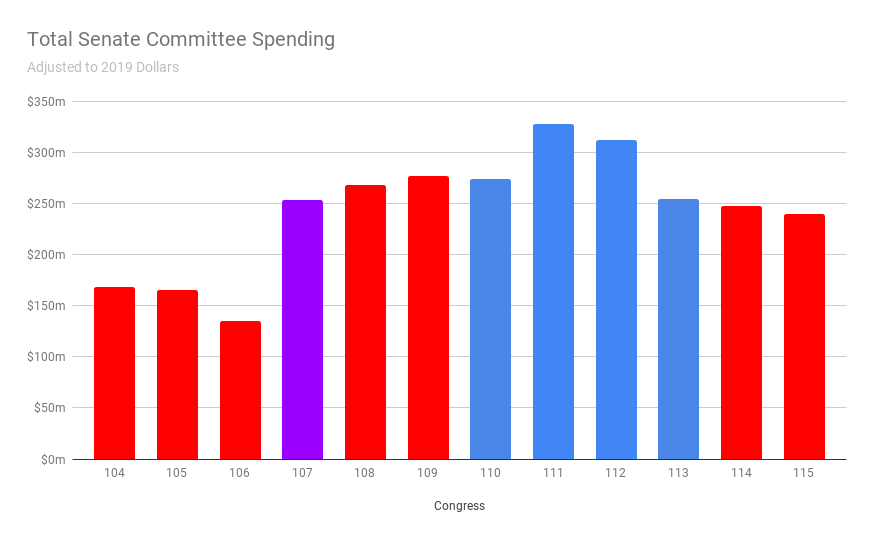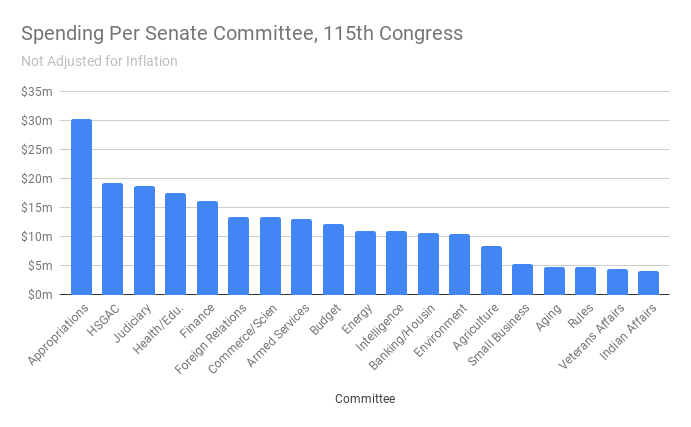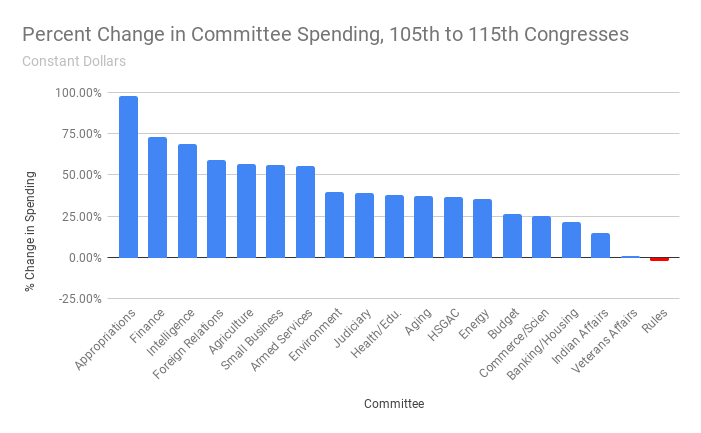TRENDS IN SENATE COMMITTEE FUNDING
How do Senate committees get their funding and how has funding changed over the last 25 years? We crunched the numbers for you and here are the highlights:
- Senate Committee spending is at an 18 year low
- It’s good to be an appropriator; the committee gets the lion’s share of the funding and doesn’t have to beg for money
- While Senate Committees aren’t exactly rolling in dough, they’re in much better shape than House committees, which are on a starvation diet
HOW SENATE COMMITTEES ARE FUNDED
Senate committees get their funding through a two-step process: authorization and appropriation.
At the beginning of each new Congress, nearly all committees submit funding resolutions to the Senate Committee on Rules and Administration (Rules Committee); some committee chairs and ranking members supplement the resolutions with testimony before the committee. The Rules Committee then drafts a resolution that authorizes the committee to spend money, which is passed by the Senate. (It can be an omnibus, like this, or there can be multiple resolutions.) Note, however, that the Senate Appropriations Committee is not subject to this authorizing process, and its funding is directly appropriated in the appropriations bill. (For an example, see line 14 of page 3.)
The Rules Committee sets a ceiling on how much money each committee that it authorizes spending for may access during designated calendar periods: March 1 to September 30 of the first year of a Congress, October 1 to September 30 of the following year, and from October 1 to end of the following February.
Appropriations for committee funding occur annually prior to the start of the fiscal year on October 1. The Legislative Branch appropriations subcommittee appropriates a lump sum of money for all Senate committees (except for the appropriations committee and conference committees, which are provided for separately).
It’s important to note that these two cycles, authorization and appropriations, operate on two entirely different calendars. Committee authorizations are usually for two years and the resolution is usually passed by March 1. The appropriations cycle usually takes place prior to the start of the fiscal year on October 1.
The Legislative Branch appropriations subcommittee generally does not dictate spending levels for each individual committee — that happens through the committee authorization process, described above — nor does it govern how funding for staff will be divided between the majority and minority. The division of staff between majority and minority is governed by Senate Rule XXVII, and reflects the relative majority and minority composition of the committee.
HOW FUNDING FOR COMMITTEES HAS CHANGED OVER THE LAST 25 YEARS
How has this process played out over the last quarter century or so? We used data from this CRS report plus some of our own research to look at:
- Total committee spending from 1995 to present
- The change in spending per committee from 1997 to present
- Spending per committee in the last Congress
The takeaway? Committee spending in the Senate last Congress hit an 18-year low. Fewer funds means fewer resources for staff to do their jobs and a greater reliance on outside interests.
To check our work, you can access the un-adjusted committee spending data from 1994-2018 and the inflation adjusted committee spending data from 1994-2018.
TOTAL COMMITTEE SPENDING
If you adjust for inflation, Senate committee spending last Congress was at its lowest level since Y2K and down over $85 million from its peak in 2010.
Last Congress, the Senate spent about $239 million (in 2019 adjusted dollars) on its committees. Spending was at its highest during the Democratically-controlled 111th Congress, totalling $327.1 million (again in 2019 adjusted dollars). By contrast, the Senate spent roughly half that amount on committees during the Republican-controlled 106th Congress for a total of 167.9 million (inflation adjusted) dollars.

SPENDING PER COMMITTEE
Last Congress, the Senate spent the lion’s share of funds on the Appropriations committee, which had more money than the Intelligence, Banking, and Veterans Affairs committees combined. You can see how the remaining funds were divided in the charts below:


CHANGES IN SPENDING PER COMMITTEE
Unlike their House counterparts, almost every Senate committee has experienced an increase in spending between the 105th and 115th Congresses in inflation adjusted dollars. The magnitude of those increases, however, vary quite a bit.
The Appropriations Committee, which has consistently been the best funded committee in the Senate, has experienced an almost 100% boost in spending in inflation adjusted dollars over the last twenty years. None of the other committees’ growth rates approached triple digits. The Finance Committee came closest, with a 72% increase in spending.
It’s also worth noting that although HSGAC is the second best funded committee, its budget increase of roughly 36% is middle of the pack compared to other committees’ increases.
The Rules Committee has one of the smallest budgets in the Senate, hovering around $5 million last Congress. Still, it was the only committee that experienced a net decrease in funding. Adjusting for inflation, Rules Committee funding decreased by 2.2% from 1997 spending levels.

WHAT DOES ALL THIS MEAN?
Although committee funding levels in the Senate are down from 2010 levels, there has been a net increase in committee spending over the last two decades with the largest comparative amount going to Senate appropriators. This stands in stark contrast to trends on the House side, where committees are on a starvation diet.